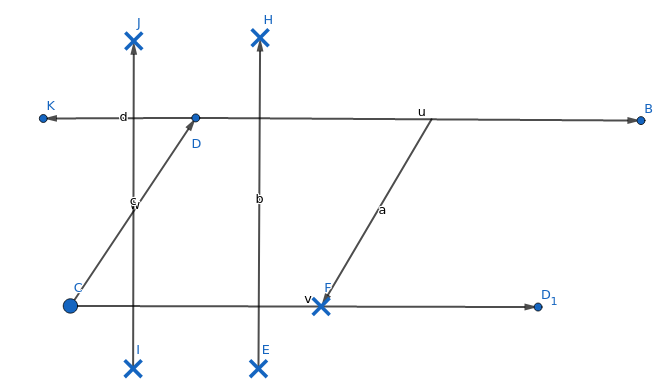
Construct a parallelogram ABCD, in which AB=6cm, BC=4.2cm and the height from AB=3.5cm.
Answer
598.8k+ views
Hint: We should draw the base AB upon which the given height is to be drawn. Then we may draw two perpendicular lines on the base at any two points and cut at 3.5cm on both the perpendiculars from their intersection points from the base and join them. Then we can take an arc of length 4.2cm from B and cut it on the line drawn through the perpendiculars and join B and this point of intersection to get the side BC. Now we can cut the line through the perpendiculars at 6cm from C and name it D. Finally, we can join A and D.
Complete step-by-step answer:

The above figure shows the parallelogram. The steps to construct it are:
Step 1- We can choose a point B and draw a line through it. Cut it at a distance of 6cm from B by an arc and name it A.
Step 2- We now draw two perpendiculars through any two points on AB. Name the points of intersections as R and S.
Step 3- We can cut the two perpendiculars by arcs at 3.5cm from R and S and name them P and Q respectively. Draw a line P and Q.
Step 4- We then cut PQ at 4.2cm by an arc from B and name the point of intersection as C. Join B and C.
Step 5- Finally, we cut PQ by an arc at 6cm from C at the side of A and name it D. At last, we join A and D to obtain the required parallelogram.
$\therefore $ ABCD is the required parallelogram with AB=CD=6cm, BC=AD=4.2cm and a height of 3.5cm.
Note: We should not build D at the opposite side of A in step 5 as D should lie on the same side of C as A lies of B, otherwise a parallelogram would not be formed.
Complete step-by-step answer:

The above figure shows the parallelogram. The steps to construct it are:
Step 1- We can choose a point B and draw a line through it. Cut it at a distance of 6cm from B by an arc and name it A.
Step 2- We now draw two perpendiculars through any two points on AB. Name the points of intersections as R and S.
Step 3- We can cut the two perpendiculars by arcs at 3.5cm from R and S and name them P and Q respectively. Draw a line P and Q.
Step 4- We then cut PQ at 4.2cm by an arc from B and name the point of intersection as C. Join B and C.
Step 5- Finally, we cut PQ by an arc at 6cm from C at the side of A and name it D. At last, we join A and D to obtain the required parallelogram.
$\therefore $ ABCD is the required parallelogram with AB=CD=6cm, BC=AD=4.2cm and a height of 3.5cm.
Note: We should not build D at the opposite side of A in step 5 as D should lie on the same side of C as A lies of B, otherwise a parallelogram would not be formed.
Recently Updated Pages
Master Class 12 Business Studies: Engaging Questions & Answers for Success

Master Class 12 Economics: Engaging Questions & Answers for Success

Master Class 12 English: Engaging Questions & Answers for Success

Master Class 12 Maths: Engaging Questions & Answers for Success

Master Class 12 Social Science: Engaging Questions & Answers for Success

Master Class 12 Chemistry: Engaging Questions & Answers for Success

Trending doubts
Who was the first woman to receive Bharat Ratna?

Write a letter to the principal requesting him to grant class 10 english CBSE

Why is there a time difference of about 5 hours between class 10 social science CBSE

What is the median of the first 10 natural numbers class 10 maths CBSE

The Equation xxx + 2 is Satisfied when x is Equal to Class 10 Maths

Discuss the main reasons for poverty in India




